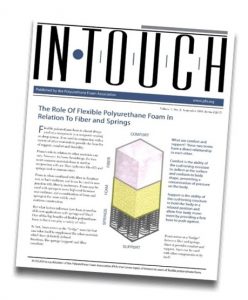The Many Performance Characteristics of Flexible Foam
Flexible polyurethane foam is preferred in so many applications because it can be formulated with a wide variety of performance characteristics. These range from the comfort and support needed for upholstered seating to the shock-absorption used to protect packaged goods, to the long-term recovery and abrasion resistance demanded by carpet cushion. The properties of foam can be measured and specified very precisely to allocate the right grade of foam to the right application.
The foam industry utilizes specialized tests, terminology and equipment to accomplish this. The following are key performance characteristics and how they are measured.
DENSITY
Density is a measurement of the mass per unit volume. Measured and expressed in pounds per cubic foot (pcf) or kilograms per cubic meter (kg/m3), density is one of the most important of all foam properties. Density is a function of the chemistry used to produce the foam and additives included with the foam chemistry. For specification purposes, it is advisable to use the polymer density of the foam, or the density of the material made up strictly by the foam chemistry without fillers or reinforcements included. Density affects foam durability and support. Typically, the higher the polymer density, the better the foam will retain its original properties and provide the support and comfort it was originally designed to produce.
FIRMNESS
Firmness is an indicator of the surface feel of the foam. It is measured using the force in pounds required to indent a foam sample by 25% of its original height. This measurement is called Indentation Force Deflection (IFD). Firmness is independent of foam density, although it is often thought that higher density foams are firmer. It is possible to have high density foams that are soft-or low density foams that are firm, depending on the IFD specification.
SUPPORT FACTOR
Support Factor (also know as Compression Modulus) assesses the foam’s ability to support weight. Quantifying support factor requires a second IFD measurement based on compressing a foam sample by 65% of its height. Typically, the more difference between the 25 percent IFD and the 65 percent IFD, the more ability the foam has to support weight. The ratio of the 65 percent IFD divided by the 25 percent IFD is called the foam’s support factor. Support factors for foam range from about 1.5 to 2.6. The higher the number, the better the ability of the foam to provide support. Foams with higher support factors offer a number of advantages, such as a sitter not “bottoming out” on a sofa or a chair. It is possible to specify a low 25 percent IFD on a foam with a high support factor to create extra surface softness without causing the foam to “bottom out” when weight is applied. Typically, the higher the foam density, the better the support factor.
FLEX FATIGUE (Dynamic Fatigue)
There are several tests that are used to determine foam durability, or how well foam retains its original firmness properties and height. Some are standard laboratory tests; others are customized tests developed by different manufacturers. But virtually all of them are based on flexing or compressing the foam a specific number of times and measuring foam firmness and height before and after testing. In flex fatigue testing, foam samples may be compressed a few thousand times, or many thousands of times. The percentage of IFD loss is then measured. Shorter tests provide an idea of how much firmness a foam may lose through initial use, while longer tests provide data on overall foam durability.
ROLLER SHEAR
A particularly severe flex fatigue test is roller shear, where a rolling weight is run over a foam sample from two directions, typically for about 25,000 cycles. This test provides a combination of compression and abrasion, and helps identify how the foam would stand up to particularly difficult applications, such as commercial furnishings or as carpet cushion. Again, IFD loss is measured, and multiple measurements may be taken, at different time periods after the foam has had a chance to “recover”.
TEAR STRENGTH
Flexible polyurethane foams are also measured for their ability to resist tearing or shredding. This is important in applications where foams must be handled frequently, such as in upholstering. The tests to determine these properties are tensile strength, tear resistance, and elongation. They determine the foam’s ability to be stretched or flexed without tearing. These durability measurements are particularly important for foams which contain large amounts of fillers, such as combustion modified foams. These additives can increase the tendency of foams to tear or shred. When specifying foams which contain additives, it is suggested that tensile strength, tear and elongation tests be reviewed to see if the foam may require special handling.
RESILIENCE
Resilience is an indicator of the surface elasticity or “springiness” of foam. Resilience can relate to comfort. Resilience is typically measured by dropping a steel ball onto the foam cushion and measuring how high the ball rebounds. Foam resilience ranges from about 20 percent ball rebound to as high as 80 percent rebound. Higher resilience in a foam often means that sofa seat cushions, for example, have a better “hand” or surface feel. Foams can also be made to have very low resilience for certain applications. Viscoelastic products typically exhibit very low resilience.
HYSTERESIS
Hysteresis is another laboratory test used to determine a foam’s ability to retain its original firmness properties. Hysteresis is measured by first indenting the foam sample 25 percent and measuring firmness, then indenting it 65 percent and again measuring firmness, and finally releasing indentation to the 25 percent level without allowing the foam to completely relax. Without fully releasing indentation, foam won’t recover all of its original 25 percent firmness, but the percentage of firmness it does recover is believed to be a good indicator of overall cushion durability.
Unlike other durability tests, Hysteresis can be performed quickly on a variety of foam samples. Roller shear is a particularly tough test of foam durability. Tests for tear strength analyze both long term durability and the foam’s ability to be handled during product assembly. A good Hysteresis rating also contributes to how easy it is to get out of a sofa or other furniture piece that is designed for people to sit deeply into the seat.
AIR FLOW
Air flow is an important diagnostic test. Foam performance is optimized when air flow is maximized. This indicates that cells are open and as flexible as they should be. A good rule of thumb for air flow in flexible polyurethane foams is a minimum of 2.0 cubic feet per minute (cfm).
An overview of ASTM standards and foam can be found in this video from PFA’s “An Introduction To The Flexible Polyurethane Foam Industry” training series:
FLAMMABILITY
Flammability performance is a characteristic relevant to applications such as home furnishings, automotive applications and aircraft seating. For more information on this topic, go to Flammability.
Key Regulations and Guidelines (Click To Open)
Resources
Foam In Relation to Fiber and Springs
InTouch Latex/FPF Foam Comparison






